Eastern purple coneflower Echinacea purpurea Powwow Wild Berry = 'Pas702917' (PBR) (Powwow Series)

ABOUT
Echinacea purpurea Powwow Wild Berry is a striking perennial known for its vibrant flowering display. This particular variety boasts a bushy and robust habit, lush with dark green, lance-shaped leaves that provide a striking contrast to the blooms. The flowers are the standout feature, characterized by their intense, deep rose-pink color. Each flower consists of a prominent, cone-shaped center that is a darker shade of pink to reddish brown, surrounded by a halo of downward-arching petals. These petals are slightly reflexed and hold their color well as they age. The plant produces a profusion of blooms throughout the season, creating a stunning visual impact in any garden setting. The blooms not only add a splash of color but also attract a variety of pollinators including butterflies and bees. The bright blooms of Echinacea purpurea Powwow Wild Berry emerge on top of sturdy stems, which makes them excellent for use in fresh cut floral arrangements. The plant's overall appearance exudes a sense of hardiness and elegance, making it a favored choice for both ornamental and wildlife-friendly gardens.
About this plant
 Names
NamesFamily
Asteraceae
Synonyms
Eastern Purple Coneflower, Purple Coneflower, Powwow Wild Berry Coneflower
Common names
Echinacea purpurea Powwow Wild Berry.
 Toxicity
ToxicityTo humans
The plant commonly known as purple coneflower is generally considered safe for human consumption. There are no significant reports of toxicity in humans from intake of this plant. It is commonly used in traditional medicine and as a dietary supplement for its supposed immune-boosting properties. However, excess consumption may lead to adverse effects such as nausea, dizziness, or allergic reactions in individuals sensitive to the plant family Asteraceae, but these are not common.
To pets
Purple coneflower is not known to be toxic to pets. It is considered non-toxic to dogs, cats, and other animals, and ingestion typically does not result in poisoning or serious health issues. As with any non-food plant, ingestion in large quantities may cause mild gastrointestinal upset such as vomiting or diarrhea, but this is rare.
 Characteristics
CharacteristicsLife cycle
Perennials
Foliage type
Deciduous
Color of leaves
Green
Flower color
Pink
Height
1-2 feet (30-60 cm)
Spread
1-2 feet (30-60 cm)
Plant type
Herb
Hardiness zones
3-8
Native area
North America
Benefits
 General Benefits
General Benefits- Attracts Pollinators: Echinacea purpurea is known to attract bees, butterflies, and other beneficial insects, enhancing pollination in the garden.
- Low Maintenance: This cultivar is drought tolerant and generally resistant to pests and diseases, making it easy to care for.
- Long Blooming: The Powwow Wild Berry offers a long flowering season from early summer to autumn, providing extended visual interest.
- Winter Interest: After the blooming season, its seed heads provide winter interest and can also serve as food for birds.
- Colorful Displays: The plant produces vibrant deep rose-purple flowers that add a splash of color to garden landscapes.
- Drought Tolerance: Once established, Echinacea purpurea is capable of withstanding periods of low water availability.
- Adaptability: It's adaptable to a range of soil types, although it prefers well-drained soil.
- Cut Flowers: The flowers are suitable for cutting and using in floral arrangements, where they exhibit good vase life.
- Habitat Enrichment: Providing habitat for insects and other wildlife, it helps to support local biodiversity.
- Hardiness: It's hardy in a variety of climates and is suitable for growing in USDA hardiness zones 3-8.
- Easy to Grow: Suitable for novice gardeners, as it does not require expert gardening skills to thrive.
 Medical Properties
Medical Properties- Immune System Support - Echinacea is believed to strengthen the immune system and reduce the severity and duration of colds and flu.
- Anti-inflammatory - The herb has been used to reduce inflammation and may be beneficial in conditions like rheumatoid arthritis.
- Antioxidant - Echinacea contains compounds that have antioxidant properties, which may help protect cells from damage.
- Antimicrobial - Some studies suggest that Echinacea can fight against various microbes, helping to prevent or treat infections.
- Wound Healing - Topically, Echinacea purpurea extracts are sometimes used on skin wounds to promote healing and reduce inflammation.
 Air-purifying Qualities
Air-purifying QualitiesThis plant is not specifically known for air purifying qualities.
 Other Uses
Other Uses- Echinacea purpurea 'Powwow Wild Berry' can be used as a natural fabric dye, providing a range of soft lavender to green hues, depending on the mordant used.
- The dried seed heads of Echinacea purpurea 'Powwow Wild Berry' can be integrated into floral arrangements, adding texture and a unique aesthetic to the composition.
- Leaves and stems of Echinacea purpurea 'Powwow Wild Berry' can be used in papermaking, contributing natural fibers and flecks of color to the handmade paper.
- This plant's sturdy, branching stems can serve as a natural framework for creating miniature fairy gardens or as supports in insect hotels.
- Pressed flowers and leaves of Echinacea purpurea 'Powwow Wild Berry' can be used in art projects such as botanical prints, bookmarks, or greeting cards.
- Photographers and artists may employ Echinacea purpurea 'Powwow Wild Berry' as a subject due to its vibrant color and distinct form, which contribute to visually engaging works.
- The plant can be used as a tool for environmental education, teaching about pollination and the importance of native plants in supporting local ecosystems.
- Echinacea purpurea 'Powwow Wild Berry' plants can be strategically placed in gardens to create visual barriers or natural dividers between different sections of the outdoor space.
- When used in rituals or ceremonies, the blooms of Echinacea purpurea 'Powwow Wild Berry' can symbolize strength and healing, despite the exclusion of medical claims.
- For culinary purposes, the petals of Echinacea purpurea 'Powwow Wild Berry' can be crystallized with sugar and used as decorative, edible adornments for desserts.
Interesting Facts
 Feng Shui
Feng ShuiThe Coneflower is not used in Feng Shui practice.
 Zodiac Sign Compitability
Zodiac Sign CompitabilityThe Coneflower is not used in astrology practice.
 Plant Symbolism
Plant Symbolism- Healing and Health: Echinacea, commonly known as coneflower, is revered for its medicinal properties. It is a symbol of physical strength and immune support, commonly associated with herbal remedies for colds and flu.
- Resilience and Survival: The robust nature of coneflower, with its ability to thrive in adverse conditions, makes it an emblem for endurance and the spirit to overcome challenges.
- Beauty and Attraction: With its striking purple-pink flowers, coneflower symbolizes a natural beauty that is unpretentious yet captivating, drawing in both people and pollinators.
- Integrity and Resourcefulness: The plant's indigenous use by Native Americans for healing purposes highlights its representation of wisdom, resourcefulness, and a connection to the land.
 Water
WaterThe Purple Coneflower requires regular watering to establish a deep and extensive root system, especially during the first growing season. Once established, it is more drought-tolerant and should be watered deeply but less frequently. The plant benefits from about 1 inch of water per week, including rainfall. If you're providing supplemental watering, this equates to about 0.623 gallons per square yard per week. Always allow the soil to dry out between watering to prevent root rot, and avoid overhead watering to reduce the chance of foliar diseases.
 Light
LightPurple Coneflower thrives best in a location that receives full sun for at least 6 to 8 hours a day. Adequate sunlight is crucial for the plant to develop strong stems and vibrant blooms. The ideal spot for this plant would be in an unobstructed area where it can soak up the rays without being shaded by larger plants or structures.
 Temperature
TemperatureThe Purple Coneflower can withstand a wide temperature range, tolerating minimum temperatures down to about -30°F, making it suitable for hardiness zones 3 through 8. The optimum growing temperature for this plant is between 65°F and 75°F. However, it's a robust plant that can survive temperature extremes once established.
 Pruning
PruningPruning the Purple Coneflower is important to promote vigorous growth and prolific blooming. Deadheading spent flowers will encourage additional blooming throughout the season. In late fall or winter, after flowering has ceased, the plant can be cut back to an inch or two above the ground. This not only helps to maintain a tidy appearance but also rejuvenates the plant for the following growing season.
 Cleaning
CleaningAs needed
 Soil
SoilConeflower 'Powwow Wild Berry' thrives in well-draining soil with a pH range of 6.0 to 8.0. A mix of loam, sand, and compost is ideal to ensure adequate drainage and nutrition. The soil should be rich in organic matter to support robust growth.
 Repotting
RepottingConeflower 'Powwow Wild Berry' does not require frequent repotting and may only need it every 2-3 years. Repotting is usually done to refresh the soil or to divide clumps that have become too large.
 Humidity & Misting
Humidity & MistingConeflower 'Powwow Wild Berry' is tolerant of a wide range of humidity levels and does not require high humidity. Average ambient humidity is sufficient, making it well-suited for outdoor garden conditions.
 Suitable locations
Suitable locationsIndoor
Ensure bright light, moderate watering, and well-draining soil mix.
Outdoor
Plant in full sun, well-draining soil, and water moderately.
Hardiness zone
3-8 USDA
 Life cycle
Life cycleEchinacea purpurea 'PowWow Wild Berry', commonly known as coneflower, begins its life cycle with seed germination, typically in early spring, requiring a period of cold stratification to break dormancy. Following germination, the seedlings develop into rosettes of leaves near the soil surface. As the plant matures, it forms upright stems and produces its distinctive purple-pink flowers, usually in its second year, continuing to bloom annually from early summer to fall. After pollination by insects, the flowers develop into cone-like seed heads containing numerous small, black seeds. These seeds will fall to the ground or can be carried by wind, allowing the plant to self-sow and continue its life cycle. In the winter, the above-ground part of the plant dies back, while the root system remains alive, enabling the plant to regrow the following spring.
 Propogation
PropogationPropogation time
Spring to early summer
The most popular method of propagation for Echinacea purpurea, commonly known as the purple coneflower, particularly the 'Powwow Wild Berry' variety, is by seed. Seeds are typically sown in late winter or early spring, about 8 to 10 weeks before the last frost date. They should be planted in a seed-starting mix, lightly covered with soil, and kept moist but not waterlogged. Germination usually occurs within 10 to 20 days at temperatures between 65 to 70 degrees Fahrenheit (18 to 21 degrees Celsius). Seedlings can be transplanted outdoors once the threat of frost has passed and they have developed several true leaves. It's essential to space the plants about 1 to 2 feet apart to ensure adequate air circulation and access to sunlight.









